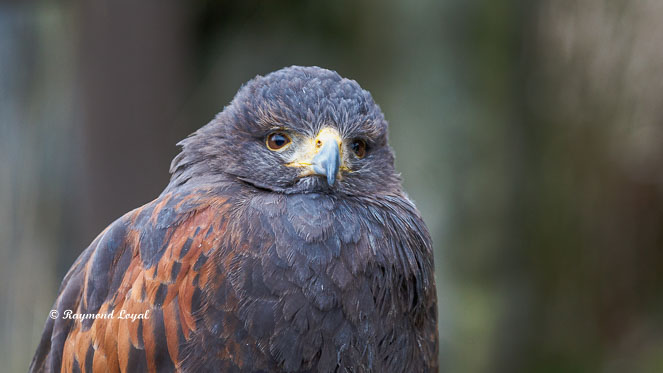Harris Hawk (Parabuteo unicintcus)
The Harris Hawk is a largish and fairly lanky buteonine. It is a native to the American continent. This parabuteo is also knwon under the name Bay-winged Hawk which is more describing the south American populations whereas Harris Hawk is the name attributed to US and Latin American populations.
This buzzard is a good hunter and kept across Europe by falconers. In fact in nearly every European country this species can be watched in zoos and falconries.
This article provides information and images on the Harris Hawk.

Geographical Variations of the Baywinged Hawk
- Parabuteo unicinctus unicintus - Distributed in north Columbia and east of Andes south to Argentina and central Chile - smaller but longer-tailed
- Parabuteo u. harrisi - Distributed in southernmost USA and in Mexico and patchily through Costa Rica, also in Panama, west Ecuador and northwest Peru - slightly larger and shorter-tailed than above unicinctus.

Description - Characteristics: Lesser Harris Hawk
Breeding – Clutch – Measurements – Habitat – Diet - Threats
Taxonomy:
Order: Accipitriformes
Family: Accipitridae
Genus: Parabuteo
Species: Lesser Harris Hawk
Scientific Name: Parabuteo unicinctus
Names and Synonyms of the Harris Hawk
Name in German: Harris Hawk - Wüstenbussard
Name in Czech: Káně Harrisova
Name in Slovak: Myšiak štvorfarebný
Name in Hungarian: Harris-ölyv
Name in Croat: Harrisov škanjac
Name in Französisch: Buse de Harris
Name in Spanish: Busardo Mixto
Name in Portuguese: Gavião-asa-de-telha
Name in Niederländisch: Woestijnbuizerd
Name in Norwegian: Kaktusvåk
Name in Finnish: Ritarihaukka
Name in Dänisch: Brunskuldret våge
Name in Swedish: Kaktusvråk
Name in Russisch: Белоголовый орлан
Characteristics of the Lesser Harris Hawk
Distribution: Southern Nearctic and Neotropical; southernmost US – southern Texas, Kansas, southern Arizona, southeast California; Mexico, parts of central America, mainly east Andes; Guatemala, El Salvador, Panama?, eastern Peru, north and east Bolivia, south and east Brazil, Paraguay, Uruguay, northern parts of Argentina, central Chile, Patagonia.
In Germany, the EU and across Europe Harris Hawks are kept in zoos and falconries.
Movements: Mostly considered sedentary. However, southern populations are partially migratory.
Habitat: open country in lowlands and foothills, swampy areas, prefers dry regions, thin or patchy woodland with adjacent scrub, open savannah, grassland, marsh with scattered trees, semi-desert with saguaro cactus. At sealevels of up to 1,500 m, even 1,800 m, in Chile at 1,900 m, Ecauador up to 3,300 m.
Behaviour Diurnal. Vergy good gliding abilities. Flight silhouette similar to harriers. Lives solitary of social, in groups of 10-15 individuals outside breeding season. At times enjoys hunting in pairs or trios. Hunts out of search flight or from perch.

Measurements
Size: ca. 56 cm
Tail: 19-27 cm
Weight:
♂: 600-840 g
♀: 820-1200 g
Wingspan: 108-123 cm
Voice: Im Brutgebiet ist das Brutpaar ruffreudig mit Rufen wie „tjück“ als Einzel- oder Reihenrufe. Langgezogener Pfiff als Warnruf. Bettelruf der Jungen (Lahnen) ähnlich „psip“.
Breeding
Sexually Mature: after 18-24 months.
Mating: monogamous breeding pair.
Clutches per breeding season: 1 clutch; though, depending on abundance of food up to three clutches per breeding season are possible
Breeding: USA from January to August (November); Costa Rica December to June; Columbia June to July; Venezuela probably at any time during the year; Argentina from July to December.
Nest: Small nest platform mainly made of twigs and lined with green leaves, grass, moss and other materials picked up in the surroundings. Nest sits in cactus in semi-desert scrub, in trees or on rock ledges.
Clutch: in the northern area 3-4 eggs (max 5), in the southern area 2 egg (max 3)
Eggs: Chicken egg size, white shell with light blue shine.
Recurrent Clutch: recurrent clutch after loss is possible.
Laying Interval: 3 days.
Beginn of incubating: Most probaly after laying first egg.
Incubation: c. 33-36 days, the ♀ is sitting on the nest incubating while the ♂ hunts and feeds the ♀.
Hatching: Chicken hatch in accordance with the laying interval.
Fledging: Chicken are huddled by ♀ during the first days. Fledging after 38 days on average, c. 37-50 days possible.
Dependency: After fledging the young Harris Hawks remain dependent on their parents for up to three mounths before leaving the breeding area.


Miscellaneous
Food: Mammals to the size of rabbits and birds to the size of gallinules (Rallidae), smaller guans, lizards, insects, maybe also carrion, also possibility of feeding on fish.
Longevity: unknown.
Mortality: no recorded data available

References
Brown, Leslie, Die Greifvögel - Ihre Biologie und Ökologie, Paul Parey Verlag Hamburg und Berlin, 1979
Ferguson-Lees, Jamie & Christie, David A., Raptors of the World, Houghton Mifflin Company Boston New York, 2001
Ferguson-Lees, Jamie; Christie, David, Raptors of the World - A Field Guide, Christopher Helm London, 2005, reprinted 2019
Grzimek, Bernhard et al (HG), Grzimeks Tierleben, Enzyklopädie des Tierreiches, Band VII , Vögel 1, Kindler Verlag AG Zürich, 1968
Schönberg, Horst, Falknerei - Der Leitfaden für Prüfung und Praxis, Verlag Peter N. Klüh Darmstadt, 3. durchgesehene Auflage 2009
Image Credits
all images by ©Raymond Loyal
